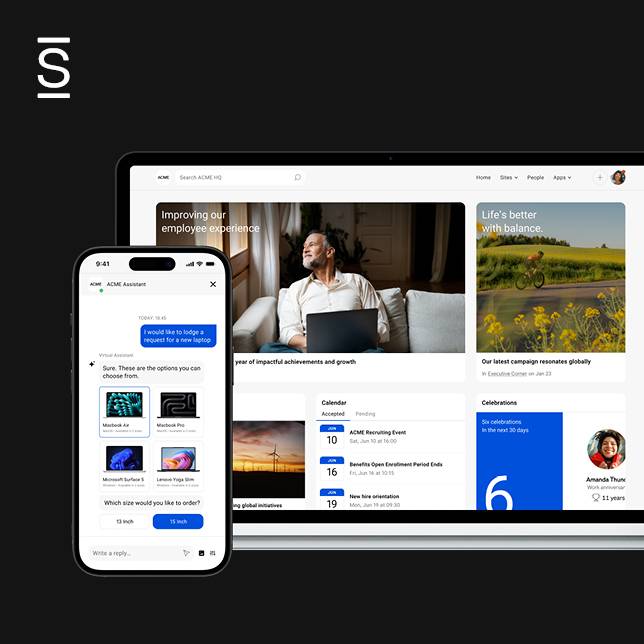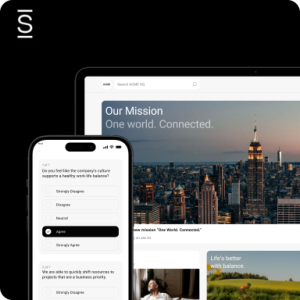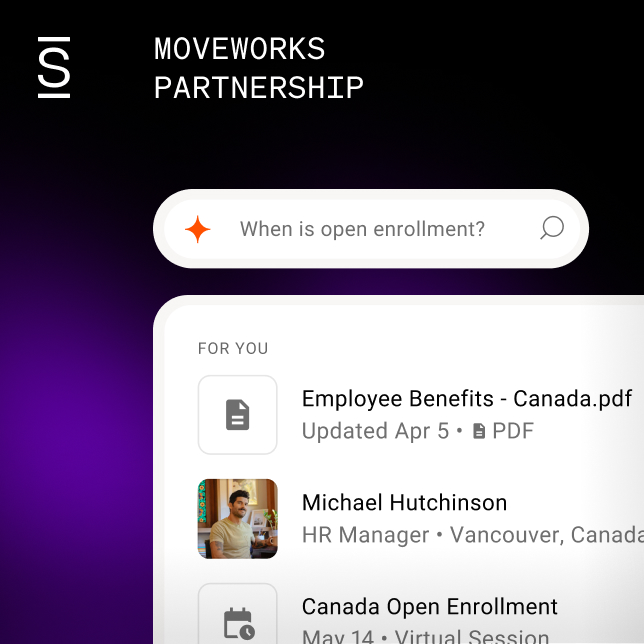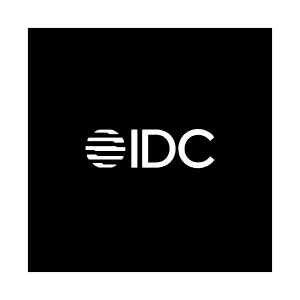Career development definition
Career development is a lifelong ongoing process that assists individuals in managing their career paths and achieving their full potential. It includes gaining new skills, setting career goals, exploring job opportunities, and making strategic decisions that help them to move forward in their career. This can happen through education, training, mentorship, job experiences, or taking on new challenges.
- 1 Why is career development important?
- 2 Benefits of career development
- 3 Steps in the career development process
- 4 Types of career development programs and activities
- 5 The employer’s role in career development
- 6 Challenges of implementing career development programs
- 7 Examples of successful career development strategies
- 8 Improve your career development strategy with Simpplr

Why is career development important?
Employees want more than a paycheck. They want to work in an organization that supports continuous learning and invests in development opportunities that align with their career goals, helps them grow in their current roles, and prepares them for what’s next. And they expect this to happen not once a quarter but in everyday workflow.
76% of employees are more inclined to stay at companies that offer continuous learning and development (L&D) opportunities (SHRM).
As the job market keeps changing, both employees and organizations are looking for ways to stay relevant and resilient.
Here are a few reasons why it is crucial to offer career development opportunities:
- Boosts job satisfaction: Providing career development opportunities can help employees feel valued, demonstrating that their employer is invested in their growth and continual development. This, in turn, results in increased professional satisfaction and motivation.
- Increases employee engagement: When employees see how their current role connects to their future goals, they bring more energy and focus to their work. This naturally leads to higher productivity and better quality outcomes.
- Creates a culture of learning and growth: Organizations that prioritize career development foster environments where learning and development become part of the daily routine. Employees start taking initiative, sharing knowledge, and looking for ways to improve processes.
- Attracts and retains top talent: When employees see that their growth is a priority, they’re more likely to stay and trust the leadership. A strong learning culture shows your people that the organization is invested in their future — not just their output. This increases retention rates and attracts new talent as employees develop a sense of belonging and purpose.

Benefits of career development
Career development offers numerous benefits for individuals and organizations, making it a worthwhile investment for organizations. Employers that incorporate career development into their structure record huge successes; these are the key benefits of career development:
Benefits for individuals:
- Gaining new skills and experiences: Allows individuals to acquire new skills, knowledge, and experiences that help bridge the skills gap. This also boosts their confidence to take on new challenges, adapt to change, and stay competitive.
- Improving job performance: Career development activities can help individuals improve their job performance by providing training and support to enhance their skills and abilities.
- Increasing earning potential: Through career development, individuals can gain the knowledge and expertise needed to pursue higher-paying positions within their industry.
Benefits for businesses:
- Building a skilled and motivated workforce: Career development opportunities can result in a highly skilled and motivated workforce dedicated to achieving the organization’s objectives.
- Improving customer satisfaction: A skilled workforce can improve customer service, resulting in improved customer satisfaction and retention.
- Increasing profitability: Career development can lead to increased productivity, innovation, and efficiency, ultimately resulting in increased profitability for the business.
A high-performance workplace that prioritizes individual development by investing in career development activities creates a future-ready workforce equipped with the skills and confidence to drive innovation, take on new challenges, and contribute meaningfully to long-term success.
Steps in the career development process
Most career development initiatives fail because they lack structure. Employees attend random training sessions, have occasional conversations with their manager, and hope something meaningful will happen. But without a clear process, career development becomes a series of disconnected activities that lead nowhere.
1. Self-assessment
This step requires individuals to identify their interests, skills, and values and evaluate them against their career aspirations. This process helps individuals better understand their strengths and weaknesses and how they can utilize them to achieve their goals.
2. Career exploration
In this step, individuals research and explore various career options that match their interests and goals. This step is crucial to identify the most suitable career path, considering their skills, education, and experience.
3. Goal setting
The next step involves defining specific and measurable career goals. Setting goals will allow individuals to focus their efforts and energies on achieving the objectives they have set for themselves.
4. Career planning
Once individuals have identified their career goals, they can develop a plan to achieve them. This plan may include education, training, certification, and other career development activities to help individuals acquire the necessary skills and experience to achieve their goals.
5. Career implementation
The final step involves the actual execution of the career plan. A practical implementation may include applying for jobs, training, networking, or pursuing further education to gain the skills and experience necessary to achieve career goals.
Types of career development programs and activities
Employers can offer various career development programs and activities to support their employees’ career growth. Here are some common types of career development programs and activities:
- Job shadowing: This program involves observing and learning from experienced employees to understand their work processes and learn new skills.
- Mentoring: A structured relationship between a more experienced and less experienced employee aimed at providing guidance and support in their career development.
- Coaching: A personalized approach focused on helping individuals achieve specific goals and improve their performance in their current roles.
- Leadership development: This program aims to develop leadership skills and prepare employees for higher-level roles.
- Tuition reimbursement: Employers can offer this benefit to help employees pursue further education or training, which can improve their skills and advance their careers.
- Professional development training: This program offers opportunities to develop new skills, expand knowledge, and stay up-to-date with industry trends.
The employer’s role in career development
Employers have a critical role in supporting the career development of their employees. Providing career development opportunities benefits employees and the organization as a whole. To keep the career development of employees, employers can take various steps, including;
- Provide resources for training and development programs: This could include funding for education, training, and development courses, certifications, and workshops that help employees build new skills and knowledge.
- Offer career guidance and coaching: Providing employees with career planning and coaching on developing their skills and competencies can help them better align their career goals with organizational goals.
- Create opportunities for advancement: Employers can offer clear career paths, promotions, and other opportunities for employees to advance their careers within the organization.
- Encourage employees to utilize resources: Ensure employees have the necessary resources, tools, and support to achieve their career aspirations. This results in a more skilled, motivated, and engaged workforce.
- Provide regular feedback: Regular feedback can help employees understand their strengths and areas for improvement, as well as identify the next steps they need to take to achieve their career goals.
Challenges of implementing career development programs
Career development programs can drive engagement and long-term growth, but implementing them isn’t always easy. Many organizations are excited about the initiative but struggle to but struggle to build structured frameworks, secure leadership support, and sustain employee participation over time. Over time, the initiative falls flat, disengagement increases, and stalled growth occurs for both employees and the business.
The gap between intention and impact often comes down to the following challenges:
- Resource constraints: Tight budgets, small teams, and outdated systems make it hard for companies to develop career development programs that actually work for everyone who needs them.
- Lack of a clear career progression framework: Most programs launch without clear frameworks. This leads to disengagement, higher turnover, and missed opportunities for internal talent development, ultimately weakening succession planning efforts.
- Insufficient management support: When leadership doesn’t actively support career development, it sends a message that growth isn’t a priority, resulting in high disengagement and low partcipation.
Examples of successful career development strategies
These real-world examples demonstrate how companies have successfully provided career development opportunities for their employees. Here are a few examples:
- Google’s “G2G” program: Google enables employees to share their knowledge and expertise with others in the company, supporting the development of skills and knowledge.
- Amazon’s “Career Choice” program: Amazon provides tuition reimbursement for employees to pursue training and certification in high-demand fields, offering employees opportunities to learn new skills and advance their careers.
- Microsoft’s “LEAP” program: Microsoft’s leadership development program helps employees develop leadership skills and prepare them for higher-level roles.
- LinkedIn’s “Career Explorers”: LinkedIn’s program that allows employees to spend time in different departments to gain exposure to other company areas.
- Southwest Airlines‘ “Career Foundations”: Southwest offers a structured approach to career development, providing employees with the skills and knowledge they need to advance their careers within the company.
Improve your career development strategy with Simpplr
Career development thrives in environments where learning is continuous, accessible, and aligned with individual goals.
Simpplr’s AI-powered intranet platform helps organizations embed learning into the flow of work. The platform enables people managers and leaders to create digital classrooms and provide the necessary training and resources in a centralized knowledge management center. This ensures valuable content never gets buried in siloed platforms.
With personalized content delivery based on role, department, and location, employees receive relevant learning opportunities tailored to their unique career paths. Whether it’s technical skills training, leadership development, or cross-functional knowledge sharing, Simpplr connects people with the right resources at the right time.
Ready to learn how Simpplr can help you improve your career development strategy in your workplace? Request a demo today!

Watch a 5-minute demo
See how the Simpplr employee experience platform connects, engages and empowers your workforce.
- #1 Leader in the Gartner Magic Quadrant™
- 90%+ Employee adoption rate










